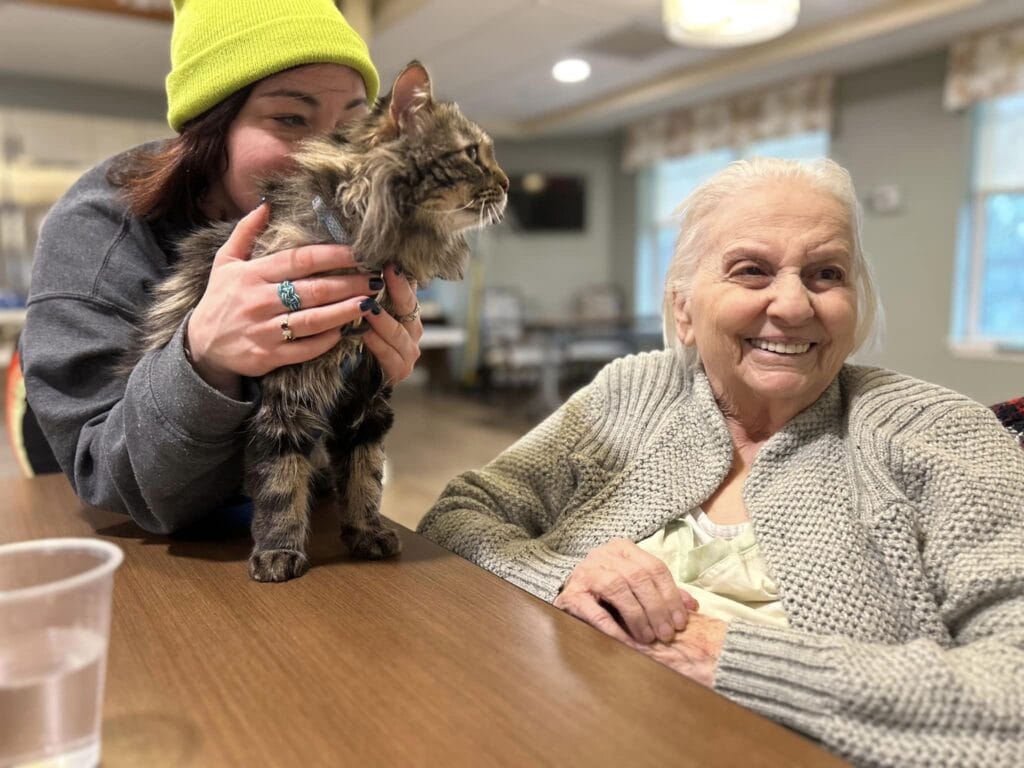“Assisted living vs. skilled nursing: which is best? More importantly, what are the differences between the two? And which is best suited given my needs?”
These are the questions that many seniors and their loved ones often find themselves asking. Many surveys of senior residents confirm that advantages and disadvantages exist with both types of facilities.
No wonder it’s so tough to know which is best!
At Village Green, we’re all about helping seniors and their loved ones live better lives. For years, we’ve been providing senior living solutions for seniors of all different needs and abilities.
We know you have questions. We’d like to provide you with the right answers.
If you’re hoping to learn more about assisted living and skilled nursing, this article is for you. First, we’ll lay out a detailed analysis of what’s included in both assisted living and skilled nursing.
Finally, we’ll conclude with our recommendations. Hop aboard! We’ll take a trip through the different living options available to seniors and their loved ones.
Assisted living explained

For starters, assisted living is for senior citizens looking for long-term care in a comfortable setting Assisted living staff help seniors with day-to-day activities. Staff generally offer five levels of care depending on a senior’s needs.
Residents in assisted living facilities generally don’t need full-time, round-the-clock medical attention. What’s more, many assisted living residents live in studio, one, or two-bedroom apartments inside a senior living community.
At the end of the day, the main focus of assisted living facilities is to provide support with activities of daily living (ADL) and instrumental activities of daily living (IADLs). Activities of daily living include everything from:
- Walking and lying down
- Toilet care
- Bathing
- Grooming
- Medication management
- Transportation
- Dressing
- Eating
- Managing finances
- Shopping
- House maintenance and cleaning
- And more
Without much-needed help with ADLs, seniors may not receive the care they need to live a safe, quality life.
Assisted living is for senior citizens who are very independent and need minimal support with day-to-day tasks. Skilled nursing is — in contrast — for senior citizens who need round-the-clock care and support with daily living.
At an assisted living facility, staff members create a care plan and determine what ADLs seniors need help with most. Let’s take a peek into what else skilled nursing facilities do.
Skilled nursing facilities explained

Skilled nursing communities differ in one major respect: the amount and type of care given. A skilled nursing facility is a healthcare institution that provides short- and long-term medical care.
Skilled nursing communities include both an on-site physician and full-time nursing staff. To boot, most skilled nursing facilities and nursing homes accept Medicaid and Medicare.
It’s important to do your research, though, as each facility is different.
Skilled nursing facilities offer more specialized medical care than assisted living facilities. Medical care includes (but isn’t limited to) IV medication, respiratory therapy, ventilator treatment, and wound care. Skilled nursing facilities’ main goal is to ensure the full health and recovery of residents, so residents can continue to maintain an independent lifestyle.
While assisted living and skilled nursing are similar, they differ in a few key areas.
Assisted living vs. skilled nursing: key differences
The difference between skilled nursing facilities and assisted living communities lies in:
- Residents’ goals
- Facility staff
- Cost of living
- Insurance taken
We’ll explore each of these categories in greater detail in the following sections.
Residents’ goals for living in each facility

When comparing assisted living communities and skilled nursing care, skilled nursing offers residences for seniors who are recovering from a medical condition.
In contrast, assisted living communities provide long-term care which focuses on providing ADL support to seniors who live an active, independent lifestyle. Since both facilities offer very different services, the level of care provided depends on each resident’s needs.
Staff differences between assisted living and skilled nursing

While the goal may be the same, the staff differ. At assisted living facilities, an on-call licensed practical nurse (LPN) must be available.
At skilled nursing facilities, a registered nurse (RN) must be on site for at least eight hours per day and seven days a week. In other words, an RN or LPN is available 24 hours per day at a skilled nursing facility.
One of the other key differences between assisted living and skilled nursing care lies in how senior facilities source staff. For example, assisted living facilities tend to contract out some of their medical services with healthcare agencies and professionals.
Regarding their similarities, each facility’s residents need help with everyday tasks. Both assisted living and skilled nursing staff aim to provide personalized care that helps residents complete tasks with greater ease.
The different settings between assisted living and skilled nursing

While assisted living and skilled nursing facilities are both in the business of helping residents thrive, their services take place in very different settings. Skilled nursing facilities provide care in medical and rehabilitation-like centers.
In contrast, assisted living care takes place in a residential setting. At Village Green, our assisted living residents enjoy community social events and activities in public spaces and private residential-like accommodations.
Assisted living communities also tend to emphasize comfort, hospitality, and amenities whereas skilled nursing facilities and nursing home care may not pay as high a premium on these luxuries.
Nevertheless, in both facilities, care for individuals is priority number one. In a word, the best senior care facility is the one that has you or your loved one’s best interest in mind.
Assisted living tends to be more affordable than skilled nursing

Speaking of best interests, you might be wondering how to pay for assisted living and skilled nursing. In general, assisted living residents don’t need as much medical attention and therefore the cost is lower.
In contrast, some skilled nursing patients may need round-the-clock medical care and supervision. Since more care is needed, skilled nursing facilities tend to be more expensive than assisted living facilities.
If you or a loved one are deciding between skilled nursing, assisted living, and other forms of long-term care, you’ll want to check whether insurance can cover some or all of the cost.
Friendly stat check
Did you know that a semi-private room and private room in a nursing home costs on average $7,908 and $9,034 per month, according to Statista.com?
In contrast, the median monthly cost of assisted living facility services in 2020 was $4,500, according to Statista.com.
Insurance coverage is more comprehensive with skilled nursing

When it comes to skilled nursing vs. assisted living, insurance will cover the cost for rehabilitation services. According to Medicare.gov, residents can expect this coverage to last for a specific amount of time and only so long as residents meet the following requirements:
- The skilled nursing facility must be certified with Medicare.
- The senior’s physician must sign off confirming that the senior needs skilled care by staff at a skilled nursing facility.
- The services required must be due to a qualifying inpatient hospital stay medical condition treated in an inpatient hospital stay or that originated while receiving care at a skilled nursing facility.
With assisted living, Medicare may cover care that’s authorized under Parts A and B of Medicare. Alas, personal care — like room and board — is not covered, though long-term care insurance may help cover some of the cost.
The good news is that many funding sources exist to cover assisted living costs. Whether you or a loved one use social security, private funding, or senior care insurance policies, you’ll have many options for covering the cost of assisted living.
Plus, if you’re wondering which options are available, skilled nursing and assisted living facilities hire employees whose job it is to help residents and their families better afford senior living services. Don’t hesitate to reach out to a senior living advisor at any point to better understand which funding options are best for you and your loved one.
Table: Comparing assisted living vs. skilled nursing

| Assisted Living Communities | Skilled Nursing Facilities | |
| Accommodations | 1. Semi-private or private apartment-style bedrooms | 1. Rehabilitation-like, clinical semi-private rooms |
| Dining | 1. Three meals served daily to residents in a communal area 2. Residents may choose to prepare or eat meals in their apartments. | 1. Three meals served daily to residents in a communal area |
| Extensive medical care provided | 1. Round-the-clock care provided for minor medical issues. 2. Assisted living facilities will arrange for a third-party healthcare provider at no extra cost to residents for extensive medical care procedures. 3. Full-time medical personnel are on-site or on call | 1. Round-the-clock care provided for minor and major medical issues 2. Many residents require 24-hour nursing care by a certified nursing staff member LPNs are available 24 hours a day, RNs are available at least 8 hours a day, and doctors are on-site or on-call 24 hours a day. |
| Help with ADLs | 1. Available at all times | 1. Available at all times |
| Payment options | 1. Mostly private funding Some assisted living facilities accept Medicaid and Medicare, among other benefit policies | 1. Mostly private funding, but is also covered by Medicare, Medicaid, and benefit policies. |
| Cost | 1. Median price = $4,500/month and up | 1. Median price = $7,900/month and up |
Which is best: assisted living or skilled nursing?

Assisted living is best for residents who don’t need round-the-clock care and who are looking for a less expensive form of senior care. At both a skilled nursing facility and an assisted living facility, different levels of care are available.
Furthermore, residents living in a skilled nursing facility tend to need more extensive medical treatment. As a result, licensed practical nurses (LPN) and other medical professionals are available on-site 24/7.
Whether you or a loved one are looking to live a life of independence or need a higher level of care, Village Green’s memory care and assisted living communities offer the right amount of medical and senior care — all with a personal touch.
Whether you’re looking for more dedicated care or a community to call home, our community focuses on delivering exceptional senior care to exceptional people like you.
If you’ve ever wondered whether assisted living or memory care is right for you or a loved one, hop on the phone and reach out to us. One of our friendly concierge staff would be delighted to answer any and all questions you might have.
Frequently Asked Questions (FAQ)

What are the main differences between assisted living and skilled nursing facilities?
Great question! The differences lie in the amount of medical care, living space, and care needed by residents. Skilled nursing residents tend to need more medical care than those in an assisted living community.
Most long-term care insurances cover skilled nursing, whereas assisted living communities don’t take as many forms of long-term care insurance. Assisted living also tends to be more affordable than skilled nursing.
Skilled nursing facilities tend to have registered nurses (RNs), licensed practical nurses (LPNs), and other medical professionals on-site 24/7. Assisted living communities have access to the same medical care, but may have the assisted living facility request care at no extra cost to the resident (if the medical personnel are not on-site already).
Finally, assisted living is best suited for seniors who are less dependent on caregivers. Skilled nursing is best suited for individuals who need round-the-clock medical and personalized care.
Do any senior living communities offer both skilled nursing and assisted living?
Yes! Many seniors find they need more medical care as they age. That’s no problem at all.
Many senior care facilities offer assisted living and other forms of medical care in the same facility. For example, at Village Green, we provide both assisted living and memory care on-site.
Residents can move into our on-site memory care wing and rest easy knowing that they won’t have to leave behind their loved ones or build a home at a new care facility.
Where can I learn more about assisted living and nursing care?
If you’re curious to learn more about assisted living and/or nursing care, the National Center for Assisted Living (NCAL) and the American Health Care Association (AHCA) are fantastic resources. You can also always visit either of our assisted living communities, Village Walk or Village Green, for helpful information about what life is like in an assisted living facility.
“She gets the help she needs.”

“No one likes giving up independence, but if you need to, here is the place to do it. This place is the next step to independent living — where you can get as much or as little help as you may need.
The entire staff is warm, welcoming, and genuinely concerned with each resident. The accommodations are beautiful and the facility is immaculate.
There are daily activities that you can choose to participate in. The meals are beautifully prepared and you can join others in the dining room or choose to stay in your room — your choice.
I would highly recommend you take a look here if you’re contemplating a change of residence for a loved one.” –Grateful Village Green family member
(Stop on by our Facebook page for more helpful reviews and other information about assisted living vs. skilled nursing.)




